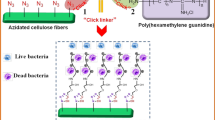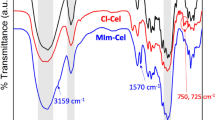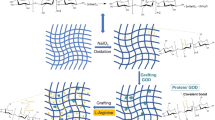Abstract
Cellulose materials do not possess any inherent antibacterial properties, which greatly limits their application in medical and food packaging fields. Antibacterial cellulose-based materials offer exciting properties and functionalities. However, they are normally prepared by using unstable physically absorbed or complicated chemically grafted antibacterial agents under harsh conditions. Herein, an eco-friendly and simple strategy is performed to fabricate long-term antibacterial cellulose-based materials. Initially, cellulose fibers (CFs) were modified by sodium periodate (NaIO4) generating dialdehyde cellulose fibers (DCFs). Afterward, the 4-aminocinnamic acid was chemically grafted onto the DCFs yielding antibacterial CFs through Schiff base reaction. The 4-aminocinnamic modified DCFs (C-DCFs) exhibited excellent antibacterial activity against S. aureus and E. coli, with inhibition ratios greater than 99.6% and 99.0%, respectively. Quite encouragingly, the C-DCFs presented long-term antibacterial effectiveness, maintaining 99% antibacterial ratio after two months of exposure to the air environment. Therefore, grafting 4-aminocinnamic acid onto the CFs endowed the CFs with robust and sustained antibacterial properties that would make the material advantageous for use in relevant applications. Our strategy is efficient, green, easy to operate both in the work-up stage and purification, in conformity to principles of green chemistry.
Graphical abstract









Similar content being viewed by others
Availability of data and materials
Not applicable.
References
Andresen M, Stenstad P, Møretrø T, Langsrud S, Syverud K, Johansson LS, Stenius P (2007) Nonleaching antimicrobial films prepared from surface-modified microfibrillated cellulose. Biomacromol 8:2149–2155
Bentiss F, Traisnel M, Gengembre L, Lagrenée M (1999) A new triazole derivative as inhibitor of the acid corrosion of mild steel: electrochemical studies, weight loss determination, SEM and XPS. Appl Surf Sci 152:237–249
Cai R, Yuan Y, Wang Z, Guo C, Liu B, Pan C, Liu L, Yue T (2015) Effects of preservatives on Alicyclobacillus acidoterrestris growth and guaiacol production. Int J Food Microbiol 214:145–150
Cai R, Miao M, Yue T, Zhang Y, Cui L, Wang Z, Yuan Y (2019) Antibacterial activity and mechanism of cinnamic acid and chlorogenic acid against alicyclobacillus acidoterrestris vegetative cells in apple juice. Int J Food Sci 54:1697–1705
Cao Y, Gu J, Wang S, Zhang Z, Yu H, Li J, Chen S (2020) Guanidine-functionalized cotton fabrics for achieving permanent antibacterial activity without compromising their physicochemical properties and cytocompatibility. Cellulose 27(10):6027–6036
Catel-Ferreira M, Tnani H, Hellio C, Cosette P, Lebrun L (2015) Antiviral effects of polyphenols: development of bio-based cleaning wipes and filters. J Virol Methods 212:1–7
Chen L, Yu H, Deutschman C, Yang T, Tam KC (2020) Novel design of Fe-Cu alloy coated cellulose nanocrystals with strong antibacterial ability and efficient Pb2+ removal. Carbohydr Polym 234:115889
Csóka L, Božanic DK, Božanic DK, Nagy V, Dimitrijevic-Brankovic S, Luyt AS, Grozdits G, Djokovic V (2012) Viscoelastic properties and antimicrobial activity of cellulose fiber sheets impregnated with Ag nanoparticles. Carbohydr Polym 90:1139–1146
Davies LM, Harris PJ, Newman RH (2002) Molecular ordering of cellulose after extraction of polysaccharides from primary cell walls of Arabidopsis thaliana: a solid state CP/MAS 13C NMR study. Carbohydr Res 337:587–593
Demir B, Cerkez I, Worley SD, Broughton RM, Huang T-S (2015) N-halamine-modified antimicrobial polypropylene nonwoven fabrics for use against airborne bacteria. ACS Appl Mater Inter 7:1752–1757
Dong X, Wang H, Zhang H, Li M, Huang Z, Wang Q, Li X (2022) Copper-thiosemicarbazone complexes conjugated-cellulose fibers: biodegradable materials with antibacterial capacity. Carbohydr Polym 294:119839
Dorantes L, Colmenero R, Hernandez H, Mota L, Jaramillo ME, Fernandez E, Solano C (2000) Inhibition of growth of some foodborne pathogenic bacteria by Capsicum annum extracts. Int J Food Microbiol 57:125–128
Fabrega J, Luoma SN, Tyler CR, Galloway TS, Lead JR (2011) Silver nanoparticles: behaviour and effects in the aquatic environment. Environ Int 37:517–531
Fan B, Qi B, Wang P, Liu Y, Yu Y, Wang Q, Ren X (2022) Mechanically tough and regenerable antibacterial nanofibrillated cellulose-based aerogels for oil/water separation. Langmuir 38(34):10716–10727
Fei P, Liao L, Meng J, Cheng B, Hu X, Song J (2018) Non-leaching antibacterial cellulose triacetate reverse osmosis membrane via covalent immobilization of quaternary ammonium cations. Carbohyd Polym 181:1102–1111
French A (2014) Idealized powder diffraction patterns for cellulose polymorphs. Cellulose 21(2):885–896
Gadkari RR, Suwalka S, Yogi MR, Ali W, Das A, Alagirusamy R (2019) Green synthesis of chitosan-cinnamaldehyde cross-linked nanoparticles: characterization and antibacterial activity. Carbohydr Polym 226:115298
Gao S, Gao R (2017) Antibacterial cellulose composite membranes prepared in ionic liquid via phase inversion method. Chem Res Chin Univ 33(4):678–683
Gao C, Yan T, Dai K, Wan Y (2012) Immobilization of gelatin onto natural nanofibers for tissue engineering scaffold applications without utilization of any crosslinking agent. Cellulose 19:761–768
Gouda M, Ibrahim NA (2008) New approach for improving antibacterial function to cotton fabric. J Ind Text 37(4):327–339
Han S, Lee M (2009) Crosslinking reactions of oxidized cellulose fiber. II. Reactions between dialdehyde cellulose and chito-oligosaccharides on lyocell fabric. J Appl Polym Sci 112:709–714
Hassanpour A, Asghari S, Lakouraj M M, Mohseni M (2018) Preparation and characterization of contact active antibacterial surface based on chemically modified nanofibrillated cellulose by phenanthridinium silane salt. Int J Biol Macromol 115:528–539
He X, Li Y, Zhang L, Du R, Dai Y, Tan Z (2021) Preparation of 2,3-dialdehyde microcrystalline cellulose particles crosslinked with epsilon-poly-L-lysine and their antibacterial activity. Cellulose 28:2833–2847
Hu X, Liu Y, Zhu D, Jin Y, Jin H, Sheng L (2022) Preparation and characterization of edible carboxymethyl cellulose films containing natural antibacterial agents: Lysozyme. Food Chem 385:132708
Hou Q, Liu W, Liu Z, Duan B, Bai L (2008) Characteristics of antimicrobial fibers prepared with wood periodate oxycellulose. Carbohydr Polym 74:235–240
Ibrahim NA, Abo-Shosha MH, El-Shafei AM, Abdel Fatah OM, Gaffar MA (2006) Antibacterial properties of ester-crosslinked cellulose-containing fabrics post treated with metal salts. Polym Plastic Technol Eng 45(6):719–727
Isquith AJ, Abbott EA, Walters PA (1972) Surface-bonded antimicrobial activity of an organosilicon quaternary ammonium chloride. Appl Microbiol 24:859–863
Jia Y, Li J (2015) Molecular assembly of Schiff base interactions: construction and application. Chem Rev 115:1597–1621
Jia R, Tian W, Bai H, Zhang J, Wang S, Zhang J (2019) Sunlight-driven wearable and robust antibacterial coatings with water-soluble cellulose-based photosensitizers. Adv Healthc Mater 8(5):1801591
Keshk S, Haija MA (2011) A new method for producing microcrystalline cellulose from Gluconacetobacter xylinus and kenaf. Carbohydr Polym 84:1301–1305
Keshk SMAS, Ramadan AM, Bondock S (2015) Physicochemical characterization of novel Schiff bases derived from developed bacterial cellulose 2,3-dialdehyde. Carbohydr Polym 127:246–251
Kim UJ, Kuga S, Wada M, Okano T, Kondo T (2000) Periodate oxidation of crystalline cellulose. Biomacromol 1:488–492
Lafay S, Gil-Izquierdo A (2007) Bioavailability of phenolic acids. Phytother Res 7:301–311
Lebrini M, Lagrene M, Traisnel M, Gengembre L, Vezin H, Bentiss F (2007) Enhanced corrosion resistance of mild steel in normal sulfuric acid medium by 2,5-bis(n-thienyl)-1,3,4-thiadiazoles: electrochemical, X-ray photoelectron spectroscopy and theoretical studies. Appl Surf Sci 253:9267–9276
Li M, Liu X, Liu N, Guo Z, Singh PK, Fu S (2018) Effect of surface wettability on the antibacterial activity of nanocellulose-based material with quaternary ammonium groups. Colloid Surf A 554:122–128
Lin H, Yao L R, Chen Y Y, Wang H (2008) Structure and properties of silk fibroin modified cotton. Fibers Polym 9(2):113–120
Liu W, Wu Y, Wang C, Li HC, Wang T, Liao CY, Cui L, Zhou QF, Yan B, Jiang GB (2010) Impact of silver nanoparticles on human cells: effect of particle size. Nanotoxicology 4:319–330
Liu ZH, Fatehi P, Sadeghi S, Ni YH (2011) Application of hemicelluloses precipitated via ethanol treatment of prehydrolysis liquor in high-yield pulp. Bioresour Technol 102:9613–9618
Luo H, Lan H, Cha R, Yu X, Gao P, Zhang P, Han L, Jiang, X (2021) Dialdehyde Nanocrystalline Cellulose as Antibiotic Substitutes against Multidrug-Resistant Bacteria. ACS Appl Mater Interfaces 13(29):33802–33811
Mascotti ML, Bisogno F, Lima B, Kurina-Sanz M, Feresin GE, Enriz RD, Giannini FA (2010) Antibacterial activity of phenylpropanoids derived from cinnamic acid. Lat Am J Pharm 29:1035–1037
Maunu S, Liitiä T, Kauliomäki S, Hortling B, Sundquist J (2000) 13C CPMAS NMR investigations of cellulose polymorphs in different pulps. Cellulose 7:147–159
Mayer S, Tallawi M, Luca ID, Calarco A, Reinhardt N, Gray LA, Drechsler K, Moeini A, Germann N (2021) Antimicrobial and physicochemical characterization of 2,3-dialdehyde cellulose-based wound dressings systems. Carbohydr Polym 272:118506
Mou K, Li J, Wang Y, Cha R, Jiang X (2017) 2,3-Dialdehyde nanofibrillated cellulose as a potential material for the treatment of MRSA infection. J Mater Chem B 5(38):7876–7884
Natella F, Nardini M, Di Felice M, Scaccini C (1999) Benzoic and cinnamic acid derivatives as antioxidants: structure-activity relation. J Agric Food Chem 47:1453–1459
Park D, Wang J, Klibanov AM (2006) One-step painting-like coating procedures to make surfaces highly and permanently bactericidal. Biotechnol Prog 22:584–589
Park S, Baker JO, Himmel ME, Parilla PA, Johnson DK (2010) Research cellulose crystallinity index: measurement techniques and their impact on interpreting cellulase performance. Biotechnol Biofuels 3:10
Poças MF, Oliveira JC, Pereira JR, Hogg T (2010) Consumer exposure to phthalates from paper packaging: an integrated approach. Food Addit Contam 27:1451–1459
Rostami M, Yousefi M, Khezerlou A, Mohammadi MA, Jafari SM (2019) Application of different biopolymers for nanoencapsulation of antioxidants via electrohydrodynamic processes. Food Hydrocoll 97:105170
Saini S, Belgacem MN, Salon M-CB, Bras J (2016a) Non leaching biomimetic antimicrobial surfaces via surface functionalisation of cellulose nanofibers with aminosilane. Cellulose 23:795–810
Saini S, Falco CY, Belgacem MN, Bras J (2016b) Surface cationized cellulose nanofibrils for the production of contact active antimicrobial surfaces. Carbohydr Polym 135:239–247
Saini S, Belgacem MN, Bras J (2017) Effect of variable aminoalkyl chains on chemical grafting of cellulose nanofiber and their antimicrobial activity. Mater Sci Eng C 75:760–768
Siller M, Amer H, Bache M, Roggenstein W, Rosenau T, Potthast A (2015) Effects of periodate oxidation on cellulose polymorphs. Cellulose 22:2245–2261
Song X, Zhang L, Wang Y, Zhao R, Sun X, Tian Y, Sun R, Hua C, Bai R, Wang C, Gao S (2022) Long term antibacterial effect cellulose film was modified with polyhexamethylene biguanide (PHMB). Ind Crop Prod 184:115038
Sova M (2012) Antioxidant and antimicrobial activities of cinnamic acid derivatives. Mini-Rev Med Chem 12:749–767
Sun B, Hou QX, Liu ZH, Ni YH (2015a) Sodium periodate oxidation of cellulose nanocrystal and its application as a paper wet strength additive. Cellulose 22:1135–1146
Sun X, Wu Q, Ren S, Lei T (2015b) Comparison of highly transparent all-cellulose nanopaper prepared using sulfuric acid and TEMPO-mediated oxidation methods. Cellulose 22:1123–1133
Sun L, Yang S, Qian X, An X (2020) High-efficacy and long term antibacterial cellulose material: anchored guanidine polymer via double “click chemistry.” Cellulose 27:8799–8812
Tavakolian M, Jafari SM, van de Ven TG (2020) A review on surface-functionalized cellulosic nanostructures as biocompatible antibacterial materials. Nanomicro Lett 12(1):1–23
Tiller JC, Liao C-J, Lewis K, Klibanov AM (2001) Designing surfaces that kill bacteria on contact. Proc Natl Acad Sci USA 98:5981–5985
Visakh PM, Thomas S (2010) Preparation of bionanomaterials and their polymer nanocomposites from waste and biomass. Waste Biomass Valoriz 1:121–134
Wang R, Xue H, Leng J, Zhang J, Yan Z, Liu X, Feng H, Xiao L, Zhu W (2022) Preparation and antibacterial properties of hemp cellulose-based material based on Schiff base between lysine grafted N-halamine and dialdehyde hemp. Ind Crop Prod 176:114388
Wei L, Song J, Cheng B, Yang Z (2020) Synthesis, characterization and antibacterial properties of novel cellulose acetate sorbate. Carbohydr Polym 243:116416
Weishaupt R, Zünd JN, Heuberger L, Zuber F, Faccio G, Robotti F, Ferrari A, Fortunato G, Ren Q, Maniura-Weber K, Géraldine Guex A (2020) Antibacterial, cytocompatible, sustainably sourced: cellulose membranes with bifunctional peptides for advanced wound dressings. Adv Healthc Mater 9:e1901850
Whitney BM, Williams RC, Eifert J, Marcy J (2008) High pressures in combination with antimicrobials to reduce Escherichia coli O157:H7 and salmonella agona in apple Juice and orange juice. J Food Prot 71:820–824
Wu Y, Li Q, Zhang X, Li Y, Li B, Liu S (2019) Cellulose-based peptidopolysaccharides as cationic antimicrobial package films. Int J Biol Macromol 128:673–680
Xu Y, Shi Y, Lei F, Dai L (2020) A novel and green cellulose-based Schiff base-Cu (II) complex and its excellent antibacterial activity. Carbohydr Polym 230:115671
Xu Y, Xu Y, Deng W, Chen H, Xiong J (2023) Extracting dialdehyde cellulose nanocrystals using choline chloride/urea-based deep eutectic solvents: a comparative study in NaIO4 pre-oxidation and synchronous oxidation. Int J Biol Macromol 246:125604
Yin N, Du R, Zhao F, Han Y, Zhou Z (2019) Characterization of antibacterial bacterial cellulose composite membranes modified with chitosan or chitooligosaccharide. Carbohydr Polym 229:115520
Zhang L, Ge H, Xu M, Cao J, Dai Y (2017) Physicochemical properties, antioxidant and antibacterial activities of dialdehyde microcrystalline cellulose. Cellulose 24:2287–2298
Zhang L, Yan P, Li Y, He X, Dai Y, Tan Z (2020) Preparation and antibacterial activity of a cellulose-based Schiff base derived from dialdehyde cellulose and L-lysine. Ind Crops Prod 145:112126
Zhang Z, Whitten DG, Kell A (2022) Fluorescent cellulose wipe as a new and sustainable light-activated antibacterial and antiviral agent. ACS Mater Lett 4:356–362
Zhang Y, Deng W, Liu C, Yan F, Wu M, Cui Q, Willför S, Xu C, Li B (2023) Preparation of antibacterial dialdehyde nanocellulose using LiBr·3H2O non-dissolving pretreatment promoted periodate oxidation. ACS Sustain Chem Eng 11:6641–6651
Zhao M, Qi Z, Chen F, Yue X (2014) Kinetics of nonIsothermal decomposition of cinnamic acid. Russ J Phys Chem A 88(7):1081–1084
Zmejkoski DZ, Markovic ZM, Mitic DD, Zdravkovic NM, Kozyrovska NO, Bugarova N, Markovic BMT (2022) Antibacterial composite hydrogels of graphene quantum dots and bacterial cellulose accelerate wound healing. J Biomed Mater Res Part B Appl Biomater 110:1796–1805
Acknowledgments
This work was supported by the Fundamental Research Funds for the Central Universities (2572020BB06) and Open Research Foundation of Hubei Provincial Key Laboratory of Green Materials for Light Industry (202307B01).
Funding
This work was supported by the Fundamental Research Funds for the Central Universities (Grant No. 2572020BB06) and Open Research Foundation of Hubei Provincial Key Laboratory of Green Materials for Light Industry (202307B01).
Author information
Authors and Affiliations
Contributions
QD: designed the study, performed the research, analyzed the data, and wrote the paper. PS: conceived the study and collected the data. JH: carried out the literature search and analyzed the data. MW: carried out the supplementary experiments. XL: conceived the study and analyzed the data. DY: conceived the study, designed the study, and provided the foundation support. SL: conceived the study and collected important background information. XQ: provided assistance in data acquisition. All authors reviewed the manuscript.
Corresponding author
Ethics declarations
Competing interests
The authors declare no competing interests.
Conflict of interest
All authors declare that they have no known competing financial interests or personal relationships that could have appeared to influence the work reported in this paper.
Ethics approval and consent to participate
Not applicable.
Consent for publication
Not applicable.
Additional information
Publisher's Note
Springer Nature remains neutral with regard to jurisdictional claims in published maps and institutional affiliations.
Rights and permissions
Springer Nature or its licensor (e.g. a society or other partner) holds exclusive rights to this article under a publishing agreement with the author(s) or other rightsholder(s); author self-archiving of the accepted manuscript version of this article is solely governed by the terms of such publishing agreement and applicable law.
About this article
Cite this article
Duan, Q., Shi, P., Huo, J. et al. Preparation, characterization and antibacterial properties of 4-aminocinnamic acid-modified cellulose fibers. Cellulose 30, 10825–10839 (2023). https://doi.org/10.1007/s10570-023-05563-4
Received:
Accepted:
Published:
Issue Date:
DOI: https://doi.org/10.1007/s10570-023-05563-4




